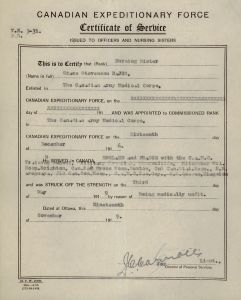|
In memory of those who have Crossed the Bar
Lieutenant Grace Stevenson Bajus, Canadian Army Medical Corps by Ryan Gingras
Early life: Born 1 September 1891 at Kingston, ON to Mrs. Grace (nee Stevenson)Bajus, Mother, 47 Rideau Street, Kingston, Ontario. Her father, Philip Bajus died in 1893, he managed the Bajus beer brewery in Kingston, ON.Grace was a nurse prior to attesting for service with the C.E.F.
Enlisted: Grace enlisted at Kingston, Ontario as a Nursing Sister (Army), with the Canadian Army Medical Corps 16 December 1916.
CAMC: The Canadian Army Medical Corps (CAMC) played a vital role in World War I, providing crucial medical support to Canadian troops during the war. The CAMC was responsible for the care of wounded and sick soldiers, as well as convalescents, prisoners of war, and even civilians on occasion.
The CAMC provided various medical services, including field ambulances, casualty clearing stations, and general and stationary hospitals in the UK and on the continent.
Nursing Sisters: During World War I, over 3,100 Canadian women served as Nursing Sisters in the Canadian Army Medical Corps (CAMC). These women, often nicknamed "bluebirds" due to their blue uniforms and white veils, were the first women to hold officer rank in the British Commonwealth, with relative rank and equal pay to men. They worked in various medical establishments, from forward areas near the front lines to fully equipped hospitals further behind the lines.
Service: During the first world war Grace served in Canada and overseas. She first served in England and then to a theatre of war in France. She was both employed as a nurse as well an instructor/ teacher.
Grace was admitted to Kitchener Military Hospital, 23 March 1917 with illness. She left 15 April 1917, diagnosed with acute infection of left frontal atrium. Transferred to Vincent sq. Hospital 16 April 1917 to 24 April 1917 for convalescence.
Overseas: Grace was posted to the Canadian Red Cross at Buxton, England. She arrived at Buxton on 27 November 1917. From England she departed overseas (France) 6 November 1917, reporting to No.2 Canadian General Hospital, Le Tréport, France, 7 November 1917.
No.2 C.G.HP:No.2 Canadian General Hospital stationed at Le Tréport on the coast of Normandy from March 1915 to March 1919 in the Great War. It was equipped with 1040 beds for patients.
Grace returned to England (Eastbourne) 13 February 1918 posted to No.14 Canadian General Hospital. While in England in 1918 she was admitted to hospital with influenza.
HMHS:24 June 1918, Grace was posted to HMHS ARAGUAYA-Canadian Hospital Ship.
HMHS ARAGUAYA: was commissioned as a hospital ship by the British Admiralty on 2 May 1917. She made one trip to Canada, in June 1917, with a Royal Army Medical Corps (RAMC) unit on board. Returning to England she sighted a German submarine north of Ireland. Upon arrival at Liverpool in September 1917, she was transferred to Canadian operational control and the CAMC staff previously on LETITIA took over the hospital. ARAGUAYA made nine voyages as a Canadian hospital ship before her commission was revoked on the recommendation of the British Admiralty.
21 September 1918, Grace was posted from HMHS ARAGUAYA, struck of strength (S.O.S.) 5 October 1918, posted to No.12 Canadian General Hospital.
Hospital: Admitted to No. 12 Canadian Hospital at Bramshott, England 5 October 1918-20 October 1918, diagnosed with influenza. While on leave, she fell on her knee, she was admitted to No. 12 Cdn Hosp. 30 October 1918-8 November 1918, diagnosed Synovitis left knee joint. Transferred to Northwood Hospital Buxton, 9 November 1918, diagnosis Synovitis, left knee.
She would have been posted to CAMC A.A.S. Coy (Ambulance Advanced Section Company). However, due to her medical limitations she ceased to be shown for the posting22 November 1918. On 8 January 1919 she was transferred to C.E.F. Canada (invalided).
Unfit for service:On 3 May 1919, Grace was released from service, after being deemed unfit for service. Her service records with the C.E.F. have multiple medical forms from her. The reasons for her release founded by the A.D.M.S. London board were AC Frontal & Antrum Abscess.
However it was primarily her left knee inflammation of the synovial membrane, which lines the knee joint. This inflammation can cause pain, swelling, and stiffness in the knee. Synovitis is commonly caused by overuse or trauma but can also be associated with inflammatory arthritis.
She had injured her knee in an accident while preceding on duty. She was admitted to hospital. She was first unfit for any duties being put on bedrest for 2 weeks. Following that period she was examined again, she was in pain and the medical board deemed her unfit any duties for an additional week.
Following that week of rest, she was examined again, this time she was deemed fit for general service. She again reported to hospital where it was determined that Grace was unfit any service for 6 months. She was returned to a hospital in Canada on 10 December 1918.
Post war: Grace had served in France a theatre of war and the board found her disabilities were pensionable. She returned to Kingston, Ontario after her release from the C.E.F.
Lest we forget: Lieutenant Grace Bajus died 13 June 1927 at Frontenac, Ontario (Kingston) age 36.
Medals Awarded: British War Medal. Grace was likely also awarded the Victory Medal.
Legacy: LieutenantGrace Stevenson Bajus, a Nursing Sister during the Great War was one of the first womento hold officer rank in the British Commonwealth, with relative rank and equal pay to men. Her services throughout Canada, England, France and aboard HMHS ARAGUAYA were of critical importance to the care and recovery of the many wounded.
Ships served in:
Service file documents for Grace Bajus Researched by Ryan Gingras
|


